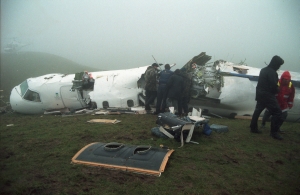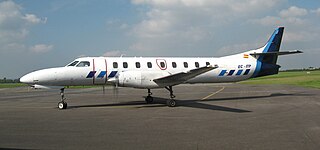
An aviation accident is defined by the Convention on International Civil Aviation Annex 13 as an occurrence associated with the operation of an aircraft, which takes place from the time any person boards the aircraft with the intention of flight until all such persons have disembarked, and in which (a) a person is fatally or seriously injured, (b) the aircraft sustains significant damage or structural failure, or (c) the aircraft goes missing or becomes completely inaccessible. Annex 13 defines an aviation incident as an occurrence, other than an accident, associated with the operation of an aircraft that affects or could affect the safety of operation.

On the evening of February 1, 1991, USAir Flight 1493, a Boeing 737-300, collided with SkyWest Airlines Flight 5569, a Fairchild Swearingen Metroliner turboprop aircraft, upon landing at Los Angeles International Airport (LAX). As Flight 1493 was on final approach, the local controller was distracted, though air traffic was not heavy at LAX, by a series of abnormalities, including a misplaced flight progress strip and an aircraft that had inadvertently switched off the tower frequency. The SkyWest flight was told to taxi into takeoff position, while the USAir flight was landing on the same runway.

Air Transat Flight 236 was a transatlantic flight bound for Lisbon, Portugal, from Toronto, Canada, that lost all engine power while flying over the Atlantic Ocean on August 24, 2001. The Airbus A330 ran out of fuel because of a fuel leak caused by improper maintenance. Captain Robert Piché, 48, an experienced glider pilot, and First Officer Dirk DeJager, 28, glided the plane to a successful emergency landing in the Azores, saving all 306 people on board. Most of the passengers on the flight were Canadians visiting Europe or Portuguese expatriates returning to visit family in Portugal. This was also the longest passenger aircraft glide without engines, gliding for nearly 75 miles or 121 kilometres. Following this unusual aviation accident, this aircraft was nicknamed the "Azores Glider".

Pilot error generally refers to an accident in which an action or decision made by the pilot was the cause or a contributing factor that led to the accident, but also includes the pilot's failure to make a correct decision or take proper action. Errors are intentional actions that fail to achieve their intended outcomes. The Chicago Convention defines the term "accident" as "an occurrence associated with the operation of an aircraft [...] in which [...] a person is fatally or seriously injured [...] except when the injuries are [...] inflicted by other persons." Hence the definition of "pilot error" does not include deliberate crashing.

Ansett New Zealand Flight 703 was a scheduled flight from Auckland to Palmerston North. On 9 June 1995, the de Havilland Canada Dash 8-100 aircraft crashed into the Tararua Range on approach to Palmerston North. The flight attendant and three passengers died as a result of the crash; the two pilots and 15 passengers survived.

Air Tahoma Flight 185 was a scheduled cargo flight from Memphis to Cincinnati/Northern Kentucky International Airport conducted by Air Tahoma as part of a contract to freight parcels for courier firm DHL. On August 13, 2004, the flight crashed during approach to landing just one mile short of the runway. The Convair 580, which is a twin engine turboprop, was destroyed upon impact. The first officer was killed and the captain received minor injuries.

Birgenair Flight 301 was a flight chartered by Turkish-managed Birgenair partner Alas Nacionales from Puerto Plata in the Dominican Republic to Frankfurt, Germany, via Gander, Canada, and Berlin, Germany. On 6 February 1996, the Boeing 757-200 operating the route crashed shortly after take-off from Puerto Plata's Gregorio Luperón International Airport. All 189 people on board died. The cause was pilot error after receiving incorrect airspeed information from one of the pitot tubes, which investigators believe was blocked by a wasp nest built inside it. The aircraft had been sitting unused for 20 days, and without pitot tube covers in place for the preceding 2 days before the crash.

Airbus Industrie Flight 129 was an Airbus Industrie A330-321 test flight that ended in a crash on 30 June 1994 at Toulouse-Blagnac Airport, killing all seven people aboard. The last test flown was to certify the plane's takeoff capability with a single engine failure. It was the first fatal accident involving an Airbus A330 as well as the first hull loss of the type. It remained the only fatal accident involving an A330 until the crash of Air France Flight 447 on 1 June 2009.

On 26 May 2008, Moskovia Airlines Flight 9675, a Moskovia Airlines An-12 cargo aircraft crashed near Chelyabinsk, Russia. After taking off for a flight to Perm, it turned back due to a fire on board and crashed 11 kilometres from the airport, killing all nine crew members.

On 4 September 2000, a chartered Beechcraft 200 Super King Air departed Perth for a flight to the mining town of Leonora, Western Australia. The aircraft crashed near Burketown, Queensland, Australia, resulting in the deaths of all eight occupants. During the flight, the aircraft climbed above its assigned altitude. When air traffic control (ATC) contacted the pilot, the pilot's speech had become significantly impaired, and he was unable to respond to instructions. Three aircraft intercepted the Beechcraft, but were unable to make radio contact. The aircraft continued flying on a straight north-easterly heading for five hours, before exhausting its fuel and crashing 40 mi (65 km) south-east of Burketown. The crash became known in the media as the "ghost flight".

XL Airways Germany Flight 888T (GXL888T) was an acceptance flight for an Airbus A320 on 27 November 2008. The aircraft crashed into the Mediterranean Sea, 7 km off Canet-en-Roussillon on the French coast, close to the Spanish border, killing all seven people on board.

Colgan Air Flight 3407 was a scheduled passenger flight from Newark, New Jersey, US to Buffalo, New York, US on February 12, 2009. Colgan Air staffed and maintained the aircraft used on the flight that was scheduled, marketed and sold by Continental Airlines under its Continental Connection brand. The aircraft, a Bombardier Q400, entered an aerodynamic stall from which it did not recover and crashed into a house at 6038 Long Street in Clarence Center, New York at 10:17 pm EST, killing all 49 passengers and crew on board, as well as one person inside the house.

On 4 September 2010, a modified Fletcher FU-24 aeroplane on a parachuting flight from Fox Glacier Aerodrome, New Zealand, crashed shortly after take-off, killing all nine people on board.

Manx2 Flight 7100 was a scheduled commercial flight from Belfast, Northern Ireland, to Cork, Republic of Ireland. On 10 February 2011, the Fairchild Metro III aircraft flying the route with ten passengers and two crew on board crashed on its third attempt to land at Cork Airport in foggy conditions. Six people, including both pilots, died. Six passengers survived but were injured, four of them seriously.

First Air Flight 6560 was a domestic charter flight that crashed on landing at Resolute, Nunavut, Canada, on 20 August 2011. Of the 15 people on board, 12 were killed and the remaining three were severely injured. The Boeing 737-200 of First Air was operating a service from Yellowknife, Northwest Territories, when it struck a hill in cloud near Resolute Bay Airport.

Dana Air Flight 0992 was a scheduled Nigerian domestic passenger flight from Abuja to Lagos, Nigeria. On 3 June 2012, the McDonnell Douglas MD-83 aircraft serving the route suffered a dual-engine failure during its approach to Lagos. It failed to reach its intended destination and crashed onto buildings, killing all 153 people on board and six on the ground. With 159 deaths, it remains as the deadliest commercial airliner crash in Nigerian history since the Kano air disaster in 1973.

LAM Mozambique Airlines Flight 470 was a scheduled international passenger flight from Maputo, Mozambique, to Luanda, Angola. On 29 November 2013, the Embraer E190 twinjet operating the service crashed into the Bwabwata National Park in Namibia, halfway through its flight, killing all 27 passengers and 6 crew on board.

Khabarovsk United Air Group Flight 3949 was a Russian domestic passenger flight from Yuzhno-Sakhalinsk to Khabarovsk, that crashed on 7 December 1995 local time, killing all ninety-eight people aboard. The crash occurred after the aircraft had entered into a steep downward spiral during automated flight at an altitude of 10,600 metres (34,800 ft).

Sepahan Airlines Flight 5915 was a scheduled domestic passenger flight from Iranian capital Tehran Mehrabad International Airport to Tabas, South Khorasan province, Iran. On 10 August 2014, the HESA IrAn-140 twin turboprop serving the flight crashed shortly after takeoff from Mehrabad International Airport, falling into a boulevard near the Azadi Stadium. Of the 42 passengers and six crew on board, 40 people died.

Loganair Flight 6780 was a scheduled domestic flight from Aberdeen Airport to Sumburgh Airport in the Shetland Islands, Scotland. On 15 December 2014, the Saab 2000 operating the flight was struck by lightning during the approach, and then plunged faster than the aircraft's maximum operating speed. The aircraft came within 1,100 feet (340 m) of the North Sea before the pilots recovered and returned to Aberdeen. All 33 passengers and crew were unharmed.




















